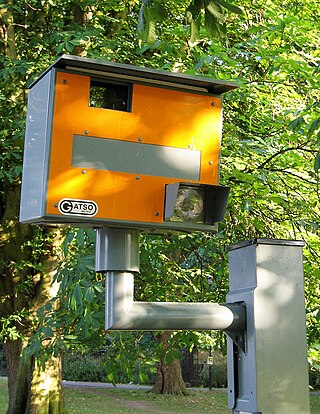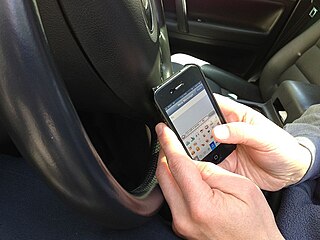
An intelligent transportation system (ITS) is an advanced application which aims to provide innovative services relating to different modes of transport and traffic management and enable users to be better informed and make safer, more coordinated, and 'smarter' use of transport networks.

A traffic enforcement camera is a camera which may be mounted beside or over a road or installed in an enforcement vehicle to detect motoring offenses, including speeding, vehicles going through a red traffic light, vehicles going through a toll booth without paying, unauthorized use of a bus lane, or for recording vehicles inside a congestion charge area. It may be linked to an automated ticketing system.

A self-driving car, also known as an autonomous car (AC), driverless car, or robotic car (robo-car), is a car that is capable of driving without human input. Self-driving cars are responsible all driving activities including perceiving the environment, monitoring important systems, and controlling the vehicle, including navigating from origin to destination.

An advanced driver-assistance system (ADAS) includes technologies that assist drivers with the safe operation of a vehicle. Through a human-machine interface, ADAS increases car and road safety. ADAS uses automated technology, such as sensors and cameras, to detect nearby obstacles or driver errors, and respond accordingly. ADAS can enable various levels of autonomous driving.

In road-transport terminology, a lane departure warning system (LDWS) is a mechanism designed to warn the driver when the vehicle begins to move out of its lane on freeways and arterial roads. These systems are designed to minimize accidents by addressing the main causes of collisions: driver error, distractions and drowsiness. In 2009 the U.S. National Highway Traffic Safety Administration (NHTSA) began studying whether to mandate lane departure warning systems and frontal collision warning systems on automobiles.

Mobile phone use while driving is common but it is considered dangerous due to its potential for causing distracted driving and subsequent crashes. Due to the number of crashes that are related to conducting calls on a phone and texting while driving, some jurisdictions have made the use of calling on a phone while driving illegal in an attempt to curb the practice, with varying levels of efficacy. Many jurisdictions have enacted laws making handheld mobile phone use illegal. Many jurisdictions allow use of a hands-free device. Driving while using a hands-free device has been found by some studies to provide little to no benefit versus holding the device itself and carrying on a conversation. In some cases restrictions are directed only at minors, those who are newly qualified license holders, or to drivers in school zones. In addition to voice calling, activities such as texting while driving, web browsing, playing video games, or phone use in general may also increase the risk of a crash.

In-car entertainment (ICE), or in-vehicle infotainment (IVI), is a collection of hardware and software in automobiles that provides audio or video entertainment. In car entertainment originated with car audio systems that consisted of radios and cassette or CD players, and now includes automotive navigation systems, video players, USB and Bluetooth connectivity, carputers, in-car internet, and WiFi. Once controlled by simple dashboards knobs and dials, ICE systems can include steering wheel audio controls, handsfree voice control, touch-sensitive preset buttons, and even touch screens on higher-end units. Latest models of In-car entertainment systems are coming equipped with rear-view cameras along with side cameras for better safety.
Intelligent speed assistance (ISA), or intelligent speed adaptation, also known as alerting, and intelligent authority, is any system that ensures that vehicle speed does not exceed a safe or legally enforced speed. In case of potential speeding, the driver can be alerted or the speed reduced automatically.
Driver drowsiness detection is a car safety technology which helps prevent accidents caused by the driver getting drowsy. Various studies have suggested that around 20% of all road accidents are fatigue-related, up to 50% on certain roads.

Texting while driving, also called texting and driving, is the act of composing, sending, or reading text messages on a mobile phone while operating a motor vehicle. Texting while driving is considered extremely dangerous by many people, including authorities, and in some places has either been outlawed or restricted. As a form of distracted driving, texting while driving significantly increases the chances that a driver will be involved in a motor vehicle accident.

Distracted driving is the act of driving while engaging in other activities which distract the driver's attention away from the road. Distractions are shown to compromise the safety of the driver, passengers, pedestrians, and people in other vehicles.
A connected car is a car that can communicate bidirectionally with other systems outside of the car. This connectivity can be used to provide services to passengers or to support or enhance self-driving functionality. For safety-critical applications, it is anticipated that cars will also be connected using dedicated short-range communications (DSRC) or cellular radios, operating in the FCC-granted 5.9 GHz band with very low latency.

Lytx is a San Diego, California based technology company that designs, manufactures and sells video telematics products used by commercial and public-sector fleets to help improve driver safety and business productivity. Products include risk detection, fleet tracking, and driver safety programs that use artificial intelligence and analysts to identify risky driving behaviors and report real-time fleet information. The company's clients include waste management and sanitation companies, trucking and distribution, government and municipality vehicles, passenger transit, construction, utilities, telecom and field services. Lytx also provides compliance services for trucking fleets regulated by the U.S. Department of Transportation.
Fatigue detection software is intended to reduce fatigue related fatalities and incidents. Several companies are working on a technology for use in industries such as mining, road- and rail haulage and aviation. The technology may soon find wider applications in industries such as health care and education.

Mobileye Global Inc. is an Israeli autonomous driving company. It is developing autonomous driving technologies and advanced driver-assistance systems (ADAS) including cameras, computer chips, and software. Mobileye was acquired by Intel in 2017 and went public again in 2022.

Various laws in the United States regulate the use of mobile phones and other electronics by motorists. Different states take different approaches. Some laws affect only novice drivers or commercial drivers, while some laws affect all drivers. Some laws target handheld devices only, while other laws affect both handheld and handsfree devices.

The use of mobile phones in schools has become a controversial topic debated by students, parents, teachers and authorities.
A textalyzer is a proposed device that would allow the police to detect illegal text messaging while driving. The device has been promoted as a means of reducing distracted driving. The device would be used by police officers who suspect that a driver has been texting while driving using similar procedures currently in place for drivers suspected of driving under the influence. The device would be connected to the driver's mobile phone and would scan the phone for calls, e-mails, or text messages sent when the driver would have been operating the vehicle.

openpilot is an open-source, semi-automated driving system by comma.ai, Inc. When paired with comma hardware, it replaces advanced driver-assistance systems in various cars, improving over the original system. As of 2023, openpilot supports 250+ car models and has 6000+ users, having covered over 90 million miles (140,000,000 km).

On 13 March 2021, a Class 507 electric multiple unit operated by Merseyrail collided with the buffer stop at Kirkby railway station, Merseyside, United Kingdom. The only injury was the driver of the train. The cause was found to be that the driver was using a mobile phone whilst driving. The distraction led him to enter the station at excessive speed. He was dismissed from Merseyrail and later prosecuted, pleading guilty to a charge of endangering the safety of people on the railway, for which he received a 12-month suspended sentence.















